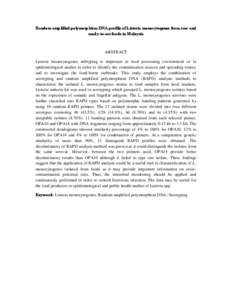Citation
Muda, Noor Marian and Syed Mohamad, Sharifah Aminah and Mat Issa @ Zakaria, Zuraini and Mustakim, Maimunah and Ahmat, Norizan and Lee, Hai Yen and Wong, Woan Chwen and Radu, Son
(2012)
Random amplified polymorphism DNA profile of Listeria monocytogenes from raw and ready-to-eat foods in Malaysia.
In: 2012 IEEE Symposium on Humanities, Science and Engineering Research (SHUSER 2012), 24-27 June 2012, Renaissance Hotel, Kuala Lumpur. (pp. 727-731).
Abstract
Listeria monocytogenes subtyping is important in food processing environment or in epidemiological studies in order to identify the contamination sources and spreading routes, and to investigate the food-borne outbreaks. This study employs the combination of serotyping and random amplified polymorphism DNA (RAPD) analysis methods to characterize the isolated L. monocytogenes strains in food samples from local markets. Listeria antisera kit was used in serotyping which grouped L. monocytogenes isolates based on the expression of somatic and flagellar antigens. The L. monocytogenes serovars were further classified into RAPD types based on polymorphic banding patterns generated by using 10 random RAPD primers. The 23 isolated strains were divided into four different serotypes consisting 4b (43.5%), 1/2b (34.8%), 4d (8.70%) and 4e (4.35%) with two untypable isolates (8.70%). 11 banding patterns were obtained from each selected primer, OPA10 and OPA14 with DNA fragments ranging from approximately 0.15 kb to 1.1 kb. The constructed dendograms showed similarity percentage of 4% to 100% for OPA10, 12% to 100% for OPA14 and 4% to 100% for combination of primers. At a comparative genetic similarity of more than 90%, 21 distinguish RAPD profiles were obtained. The discriminatory of RAPD analysis method was proven as it could distinguish the isolates from the same serovar. However, between the two primers used, OPA14 provide better discriminatory results than OPA10 although it failed to type one isolate. These findings suggest that the application of RAPD analysis could be a useful tool in characterization of L. monocytogenes isolated from foods as it may provide important information on cross-contamination potential sites. Thus, the microbial monitoring should be applied and continuously performed in order to control listeriosis infection. The data may be useful for the food producers or epidemiological and public health studies of Listeria spp.
Download File
![[img]](http://psasir.upm.edu.my/68272/1.hassmallThumbnailVersion/Random%20amplified%20polymorphism%20DNA%20profile%20of%20Listeria%20monocytogenes%20from%20raw%20and%20ready-to-eat%20foods%20in%20Malaysia.pdf)  Preview |
|
Text (Abstract)
Random amplified polymorphism DNA profile of Listeria monocytogenes from raw and ready-to-eat foods in Malaysia.pdf
Download (37kB)
| Preview
|
|
Additional Metadata
Actions (login required)
 |
View Item |

